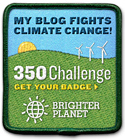Sam Knight reports from Ghana on climate-change migrants for the Financial Times:
'Most stories about environmental migration have focused on three or four so-called “canaries”: the first human habitats set to disappear. These range from the village of Shismaref in Alaska, which is falling into the sea, to entire states, like the low-lying Maldives, which now has a fund to buy land abroad for its 400,000 citizens.'
'But these stark cases do not represent the future facing most people who might become climate migrants. Friends of the Earth, which shares the 250 million estimate of environmental refugees by 2050, puts the total number of displaced people from small island states like the Maldives at 1 million. The other 249 million will come from humdrum places more like Nandom: poor, agricultural societies that have existed for a long time in marginal climates, with little room for error, but now find themselves struggling to support their populations.'
[This blog takes part today in a seminar Changing Climate Stories about migration and displacement.]
‘He’s living his best life’: drunk raccoon hit DMV for snacks before liquor
store
-
Officials say raccoon that broke into Virginia liquor store on 29 November
had previously hit DMV and karate studio
The raccoon that barged into a Virgin...
5 hours ago










No comments:
Post a Comment